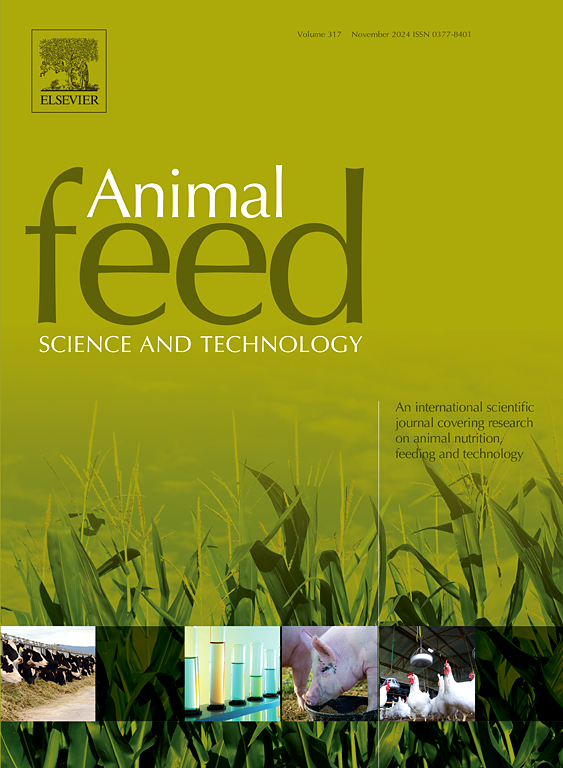Dietary supplementation with functional amino acids improves the capacity of growing pigs to cope with a health challenge
IF 2.5
2区 农林科学
Q1 AGRICULTURE, DAIRY & ANIMAL SCIENCE
引用次数: 0
Abstract
This study aimed to assess the effects of additional dietary supplementation with a blend of functional amino acids (FAA) with Thr, Trp, and Met as a preventive (prior to health challenge), curative strategy (during health challenge) or both targeting the performance, body composition, metabolic biomarkers of growing group-housed pigs raised under a health challenge. Additionally, the influence of these feeding strategies on pig response was investigated after the challenge (during the finishing phase). Sixty weaned piglets [6.3 ± 0.9 kg body weight (BW)] were distributed based on BW in a nursery barn to one of two dietary treatments (n = 30): control (CN) or supplemented with FAA blend (FAA+; 120 % of the Thr:Lys, Trp:Lys, and Met+Cys:Lys requirements) for 7 weeks. After 7 weeks, the pigs (27.9 ± 4.2 kg of BW) were distributed in a randomized complete block design to one of four treatments for the period of the health challenge period in the growing phase: pigs fed a CN diet during the nursery period were either maintained on a CN diet (control; n = 14) or switched to an FAA+ diet (curative strategy; n = 14), whereas the pigs fed an FAA+ diet during the nursery period were either fed a CN diet (preventive strategy; n = 14) or continued receiving an FAA+ diet (continuous strategy; n = 14). The health challenge consisted of subjecting growing pigs to batch mixing, poor housing conditions, and oral inoculation with Salmonella Typhimurium (ST). Poor housing conditions were maintained for 4 weeks (weeks 8–11). After this period, the pigs received the same standard diets for 9 weeks (weeks 12–20), and the facilities were cleaned daily. The health challenge increased the rectal temperature (P < 0.01) and serum concentrations of haptoglobin (P < 0.05), IgA (P < 0.05), IgG (P < 0.01), triglycerides (P < 0.01), creatinine (P < 0.01), and urea (P < 0.01), while reducing serum concentrations of lactate dehydrogenase (P < 0.01), albumin (P < 0.01), and glucose (P < 0.05). Pigs fed a continuous FAA+ diet trend towards lower fecal ST shedding (P < 0.10) than did the curative strategy pigs and had better fecal consistency scores (P < 0.01) than did the control pigs. During the challenge period, pigs fed FAA+ curatively or continuously demonstrated higher average daily gain and feed efficiency compared to control pigs (P < 0.01). Greater (P < 0.05) protein deposition (+30 %) and improved (P < 0.05) nitrogen retention efficiency (+20 % to curative and +30 % to continuous strategies) were observed in the pigs fed the FAA+ diet during the health challenge compared with the control pigs. Curative-fed FAA+ pigs had greater BW at the end of the finishing phase than did the control and preventive group (P < 0.05). In conclusion, the use of FAA supplementation as a curative or continuous strategy is highly effective at improving the performance and body composition of growing pigs under a health challenge.
膳食中补充功能性氨基酸可提高生长猪应对健康挑战的能力
本研究旨在评估额外补充含 Thr、Trp 和 Met 的混合功能性氨基酸 (FAA) 作为预防性(健康挑战前)、治疗性(健康挑战期间)或两者兼用的膳食策略对健康挑战下饲养的生长型群居猪的生产性能、身体成分和代谢生物标志物的影响。此外,还研究了这些饲喂策略对挑战后(育成期)猪只反应的影响。60 头断奶仔猪 [6.3 ± 0.9 千克体重 (BW)]被按体重分配到保育舍中的两种日粮处理之一(n = 30):对照组(CN)或添加 FAA 混合饲料组(FAA+;Thr:Lys、Trp:Lys 和 Met+Cys:Lys 需求量的 120%),为期 7 周。7 周后,猪(27.9 ± 4.2 kg 体重)按随机完全区组设计分配到生长期健康挑战期的四种处理之一:保育期喂养 CN 日粮的猪要么继续喂养 CN 日粮(对照组;n = 14),要么改喂 FAA+ 日粮(治疗策略;n = 14);而保育期喂养 FAA+ 日粮的猪要么喂养 CN 日粮(预防策略;n = 14),要么继续喂养 FAA+ 日粮(持续策略;n = 14)。健康挑战包括对生长猪进行分批混合、恶劣的饲养条件以及口服接种鼠伤寒沙门氏菌(ST)。恶劣的饲养条件持续 4 周(第 8-11 周)。在这之后的 9 周(第 12-20 周)内,猪只食用相同的标准日粮,并且每天对设施进行清洁。健康挑战使直肠温度升高(P < 0.01),血清中的血红蛋白(P < 0.05)、IgA(P < 0.05)、IgG(P < 0.01)、甘油三酯(P < 0.01)、肌酐(P < 0.01)和尿素(P < 0.01),同时降低血清中乳酸脱氢酶(P < 0.01)、白蛋白(P < 0.01)和葡萄糖(P < 0.05)的浓度。与治疗策略猪相比,连续饲喂 FAA+ 日粮的猪粪便 ST 脱落率呈下降趋势(P < 0.10),粪便稠度评分(P < 0.01)也优于对照组猪。在挑战期间,与对照组猪相比,治疗性或连续饲喂 FAA+ 的猪表现出更高的平均日增重和饲料效率(P < 0.01)。与对照组猪相比,在健康挑战期间饲喂 FAA+ 的猪蛋白质沉积更高(P < 0.05)(+30%),氮保留效率更高(P < 0.05)(治疗策略+20%,连续策略+30%)。与对照组和预防组相比,治疗组饲喂 FAA+ 的猪在育成期结束时的体重更大(P < 0.05)。总之,作为一种治疗性或持续性策略,补充 FAA 能非常有效地改善健康挑战下生长猪的生产性能和身体成分。
本文章由计算机程序翻译,如有差异,请以英文原文为准。
求助全文
约1分钟内获得全文
求助全文
来源期刊

Animal Feed Science and Technology
农林科学-奶制品与动物科学
CiteScore
6.00
自引率
6.20%
发文量
266
审稿时长
3 months
期刊介绍:
Animal Feed Science and Technology is a unique journal publishing scientific papers of international interest focusing on animal feeds and their feeding.
Papers describing research on feed for ruminants and non-ruminants, including poultry, horses, companion animals and aquatic animals, are welcome.
The journal covers the following areas:
Nutritive value of feeds (e.g., assessment, improvement)
Methods of conserving and processing feeds that affect their nutritional value
Agronomic and climatic factors influencing the nutritive value of feeds
Utilization of feeds and the improvement of such
Metabolic, production, reproduction and health responses, as well as potential environmental impacts, of diet inputs and feed technologies (e.g., feeds, feed additives, feed components, mycotoxins)
Mathematical models relating directly to animal-feed interactions
Analytical and experimental methods for feed evaluation
Environmental impacts of feed technologies in animal production.
 求助内容:
求助内容: 应助结果提醒方式:
应助结果提醒方式:


